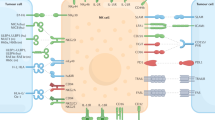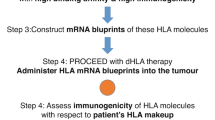Abstract
CYTOTOXIC thymus-derived lymphoctyes (T cells) from mice infected with lymphocytic choriomeningitis virus, ectromelia virus, vaccinia virus, or parainfluenza virus interact only with H–2 compatible virus-infected target cells1–6. When congenic H–2 recombinant mice7 and mice containing mutations within genes mapped at H–2K end specificities6,8 are used, recognition of virus-infected target cells by the effector lymphocytes requires compatibility at either the K or D locus of the H–2 gene complex. These observations led to the hypothesis that cytotoxic T cells recognise either a complex of viral and histocompatibility antigens or virus-induced alterations of the histocompatibility antigens. The same restriction has been described for the cytotoxic T cell response to lymphocytes modified by trinitrophenyl (TNP)9, to minor histocompatibility antigens10,11 and to the male Y antigen12. To investigate the possibility of a similarly restricted specificity of the effector cells of cell-mediated immunity to tumours, cytotoxic cells specific for SV40 tumour-associated specific antigens (SV40-TASA) were generated in two inbred strains of mice, C57BL/6J and BALB/cAn. The SV40-transformed lines C57SV (SV40-transformed C57BL/6 mouse embryo fibroblasts), MKS/Bu100 (SV40-transformed BALB/c kidney cells13) and LN-SV (SV40-transformed human skin fibroblasts14) were used as immunising and target cells (Table 1). In addition, clones of human–mouse somatic cell hybrids, obtained by fusion of LN-SV and mouse peritoneal macrophages from inbred strains15 were used. These hybrid clones contain the complete mouse genome and, in addition, one to several copies of human chromosome 7, in which the SV40 genome is presumably integrated14,15. C121, N8 and N9 cells are derived from LN-SV fused with C57BL/6 macrophages16 and C136 cells from LN-SV fused with BALB/c macrophages17. These clones express the SV40 tumour (T) antigen (a nuclear antigen)16,17, and the histocompatibility antigens of the murine parental cells (our unpublished results). Neither LN-SV nor any hybrid clones derived from LN-SV make infectious SV4018. Only after fusion with permissive monkey kidney cells can some SV40 particles be rescued. This defective virus exhibits no biological activity. Both LN-SV and human–mouse somatic cell hybrids containing the human chromosome 7 derived from LN-SV exhibit tumour-specific transplantation antigens (TSTA), as demonstrated by their ability to protect SV40-inoculated newborn hamsters from developing SV40 tumours19. Both the SV40-transformed mouse cell lines (our unpublished results) and the hybrid clones16,17 are tumorigenic in immunodeficient “nude” mice, but these cells do not grow routinely in immunocompetent syngeneic mice, probably because of strong TSTA20.
This is a preview of subscription content, access via your institution
Access options
Subscribe to this journal
Receive 51 print issues and online access
$199.00 per year
only $3.90 per issue
Buy this article
- Purchase on Springer Link
- Instant access to full article PDF
Prices may be subject to local taxes which are calculated during checkout
Similar content being viewed by others
References
Zinkernagel, R. M., and Doherty, P. C., Nature, 248, 701–702 (1974).
Doherty, P. C., and Zinkernagel, R. M., Transplant. Rev., 19, 89–120 (1974).
Gardner, I. D., Bowern, N. A., and Blamden, R. V., Eur. J. Immun., 5, 122–127 (1975).
Koszinowski, U., and Thomssen, R., Eur. J. Immun., 5, 245–251 (1975).
Lewandowski, L., Gerhard, W. U., and Plamer, J. C., Infect. Immun. (in the press).
Doherty, P. C., and Zinkernagel, R. M., Transplant. Rev., 29 (in the press).
Zinkernagel, R. M., and Doherty, P. C., J. exp. Med., 141, 1427–1436 (1975).
Zinkernagel, R. M., J. exp. Med. (in the press).
Shearer, G. M., Eur. J. Immun., 4, 527–533 (1974).
Bevan, M. J., Nature, 256, 419–421 (1975).
Bevan, M. J., J. exp. Med., 142, 1349–1364 (1975).
Gordon, R. D., Simpson, E., and Samelson, L. E., J. exp. Med., 142, 1108–1120 (1975).
Dubbs, D. R., Kit, S., DeTorres, R. A., and Anken, M., J. Virol., 1, 968–979 (1967).
Croce, C. M., Girardi, A. J., and Koprowski, H., Proc. natn. Acad. Sci. U.S.A., 70, 3617–3620 (1973).
Croce, C. M., and Koprowski, H., J. exp. Med., 140, 1221–1229 (1974).
Croce, C. M., Aden, D., and Koprowski, H., Proc. natn. Acad. Sci. U.S.A., 72, 1397–1400 (1975).
Croce, C. M., Aden, D., and Koprowski, H., Science, 190, 1200–1202 (1975).
Croce, C. M., Huebner, K., Girardi, A. J., and Koprowski, H., Virology, 60, 276–281 (1974).
Croce, C. M., Huebner, K., Girardi, A. J., and Koprowski, H., Cold Spring Harb. Symp. quant. Biol., 39, 335–343 (1975).
Wesslén, T., Acta path. microbiol. scand., 78, 479–487 (1970).
Aden, D. P., and Knowles, B. B., Immunogenetics (in the press).
Doherty, P. C., and Zinkernagel, R. M., Nature, 256, 50–52 (1975).
Author information
Authors and Affiliations
Rights and permissions
About this article
Cite this article
TRINCHIERI, G., ADEN, D. & KNOWLES, B. Cell-mediated cytotoxicity to SV40-specific tumour-associated antigens. Nature 261, 312–314 (1976). https://doi.org/10.1038/261312a0
Received:
Accepted:
Published:
Issue Date:
DOI: https://doi.org/10.1038/261312a0
This article is cited by
-
CD40 ligand and tdTomato-armed vaccinia virus for induction of antitumor immune response and tumor imaging
Gene Therapy (2014)
-
Epigenetic regulation of immune escape genes in cancer
Cancer Immunology, Immunotherapy (2006)
-
Inverse relationship between anti-SV40 TASA and anti-H-2 cytotoxic responses
Journal of Cancer Research and Clinical Oncology (1983)
-
Immunopathology of polyoma-induced tumors
Springer Seminars in Immunopathology (1982)
Comments
By submitting a comment you agree to abide by our Terms and Community Guidelines. If you find something abusive or that does not comply with our terms or guidelines please flag it as inappropriate.



